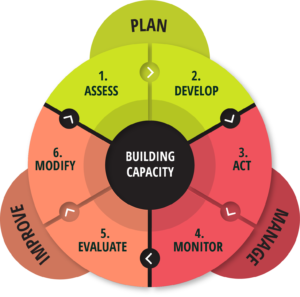ASSESS
An effective plan starts with identifying:
- the actual (not perceived) problem
- who is affected and who else is involved
- the extent of the problem and impact/s it is having.
Defining the problem can be difficult and time consuming however it is essential to know exactly what the plan is seeking to address so that appropriate management can be carried out efficiently and effectively. If the problem is not correctly defined, then all the planning that follows is likely to be distorted or at best, off track.
What is the problem?
A pest management plan should focus on minimising the damage being caused by pest animals, not the number of pests present in the area. The problem needs to be described in terms of the negative impacts that pest animals are having on people, livestock, crops, wildlife, habitat or other assets in a given area, eg lambing rates are down by 40% due to predation by
wild dogs. It is not always easy to determine the level of damage so estimates of pest density might be the only useful guide to the likely level of pest damage.
Who is affected?
Identify and involve all the key stakeholders from the beginning of the planning process. Stakeholders might include:
- affected landholders
- land, water and pest management government agencies
- contractors (eg trappers)
- community groups in the area (eg Landcare).
Involving people in the development of a pest plan ensures that it is relevant and practical, and also helps to give them ownership of the plan and its recommendations. By working together to define the problem, the group will be better prepared to discuss ways they can manage the problem cooperatively.
Where is the problem?
Pest animals typically live and/or move across the landscape where they can access suitable food and habitat. Maps are therefore an essential planning tool for effective pest management. Using a range of local and regional-scale maps with and without tenure, topography and other jurisdictional or social boundaries (eg local government area, bushfire groups), the group should mark out the areas where pest animals are causing damage (eg stock loss, pig rooting sites) and and their likely travel paths or breeding sites. This step can help to determine priority areas for management actions, and aid delegation of who does what and who pays.
DEVELOP
A pest management plan should be based on a set of clear, measurable and if possible, time-limited objectives that are aimed at reducing the level of pest animal damage to an acceptable level. Where the level of damage is not known or poorly understood, objectives related to a reduction in pest density can be used as an indication of a reduction in damage. Each objective should be:
- Specific – what exactly will be accomplished by who, where and why?
- Measurable – how will success by demonstrated?
- Achievable – is it within the means (financial or otherwise) of the group or individual responsible?
- Relevant – does it relate to the group or individual’s key responsibilities? Does it link in with other objectives and the broader plan?
- Time-bound – when will it happen and how often? Are there other deadlines that need to be met (eg budget or reporting)?
What are the management options?
At this point, the group should investigate all management options and decide what action to take. Depending on the dynamics of the situation, the group might evaluate:
- control techniques – eg poison baiting, ripping, aerial or ground shooting, trapping, or a combination of techniques
- management strategies – eg one-off control or sustained management
- equipment and access to skilled labourers
- availability of funding now and over the life of the plan.
It is also important to consider whether management is socially and politically desirable, and if it is actually practical, given the level of resources.
Do a risk/benefit analysis:
Once management actions have been decided upon, the group should weigh up the expected costs and risks of pest management against the likely benefits and outcomes. If the plan is going to be expensive to implement or has the potential to harm people, other animals or the environment, then it is important to consider if the social, environmental and economic benefits will be worth the risk and/or the financial outlay. Sometimes a management plan is implemented because the risk of not doing something about the problem is greater than the undesirable outcomes of management.
Develop a detailed outline of how the plan will be put into action.
The group needs to decide who will be driving the operation, who will carry out what tasks and when, how information will be collected and managed, who will pay the costs of management and any other details related to implementation of the plan.
It is also essential to define how information will be communicated among stakeholders and participants (eg through regular meetings, newsletters, field days) so they have real input and ownership of the program, rather than it being conveyed in a ‘top-down’ manner.
Strategic pest management is when control is carried out according to the plan of action. Coordination of control with adjacent land managers is the best approach, and is more likely to occur if key stakeholders have been involved in developing the plan from the start.
It is vital to keep everyone motivated and on track during this stage of the plan to ensure that the desired outcomes are achieved.








